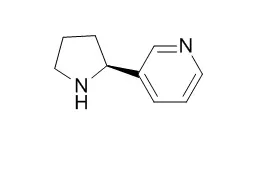| Description: |
Nornicotine serves as the direct precursor in the synthesis of N'-nitrosonornicotine, a potent carcinogen in laboratory animals. Nornicotine and nicotine can promote endothelial cellular proliferation, migration and tube formation of HUVECs in vitro.Nornicotine and nicotine each produced a dose-dependent decrease in nicotine self-administration, nornicotine may be an effective treatment for tobacco dependence. S(-)-Nornicotine may be of value, either alone or in combination with an opioid, for treatment of a broad-spectrum of pain (i.e. nociceptive, neuropathic, and mixed pain).Nornicotine inhibits striatal dopamine transporter (DAT) function via a nicotinic receptor (nAChR) -mediated mechanism. |
| In vivo: |
| Psychopharmacology (Berl). 2000 Oct;152(3):289-94. | | Nornicotine pretreatment decreases intravenous nicotine self-administration in rats.[Pubmed: 11105939] | Nicotine has been shown to be effective as a treatment for reducing tobacco dependence. However, few studies have examined the effect of other nicotinic agonists to determine if they can also decrease nicotine self-administration. The present study determined if Nornicotine, a tobacco alkaloid and major nicotine metabolite in brain, could reduce nicotine self-administration in rats.
METHODS AND RESULTS:
Each rat was prepared with an indwelling jugular catheter and trained to self-administer intravenous nicotine (0.03 mg/kg per infusion). After nicotine self-administration stabilized, rats were pretreated with either (-)-nicotine (0, 0.1, 0.3, and 1.0 mg/kg free base) or (+/-)-Nornicotine (0, 1, 3, 5.6, and 10.0 mg/kg free base) and assessed for nicotine self-administration. A separate group of rats was maintained on sucrose reinforced responding and pretreated with Nornicotine to determine the specificity of the pretreatment effect. In another group of rats, the time course of the pretreatment effect of either (-)-nicotine (0.56 and 1.0 mg/kg) or (+/-)-Nornicotine (5.6 and 10.0 mg/kg) was examined. Nicotine and Nornicotine each produced a dose-dependent decrease in nicotine self-administration. Furthermore, the decrease in nicotine self-administration in response to the 5.6 mg/kg Nornicotine pretreatment was specific to nicotine self-administration, as this dose did not decrease sucrose reinforced responding in tolerant animals. In addition, within the dose range tested, the suppressant effect of Nornicotine had a two-fold longer duration than that of nicotine (120 versus 60 min).
CONCLUSIONS:
These results suggest that Nornicotine may be an effective treatment for tobacco dependence. | | Synapse. 2007 Mar;61(3):157-65. | | Nornicotine inhibition of dopamine transporter function in striatum via nicotinic receptor activation.[Pubmed: 17146768] | Nornicotine, a tobacco alkaloid and N-demethylated nicotine metabolite, releases DA from superfused rat striatal slices in a mecamylamine-sensitive manner, indicating nicotinic receptor (nAChR) modulation of this response.
METHODS AND RESULTS:
The current study determined the effect of Nornicotine on rat striatal dopamine transporter (DAT) function using in vivo voltammetry. In a dose-related and mecamylamine-sensitive manner, Nornicotine (0.35-12.0 mg/kg, s.c.) decreased DA clearance, suggesting that Nornicotine inhibits striatal DAT function via a nAChR-mediated mechanism. Furthermore, the nAChRs mediating the Nornicotine-induced inhibition of DAT function appear to be different from those activated by nicotine which increases DA clearance.
CONCLUSIONS:
Understanding the actions of Nornicotine in brain may have significance for emerging therapeutics and for the management of nicotine dependence. |
|






 Cell. 2018 Jan 11;172(1-2):249-261.e12. doi: 10.1016/j.cell.2017.12.019.IF=36.216(2019)
Cell. 2018 Jan 11;172(1-2):249-261.e12. doi: 10.1016/j.cell.2017.12.019.IF=36.216(2019) Cell Metab. 2020 Mar 3;31(3):534-548.e5. doi: 10.1016/j.cmet.2020.01.002.IF=22.415(2019)
Cell Metab. 2020 Mar 3;31(3):534-548.e5. doi: 10.1016/j.cmet.2020.01.002.IF=22.415(2019) Mol Cell. 2017 Nov 16;68(4):673-685.e6. doi: 10.1016/j.molcel.2017.10.022.IF=14.548(2019)
Mol Cell. 2017 Nov 16;68(4):673-685.e6. doi: 10.1016/j.molcel.2017.10.022.IF=14.548(2019)